European stocks opened cautiously due to mixed performance among major indices amid uncertain trade talks.
A new Boeing 737 MAX has arrived in China, marking the resumption of deliveries as US-China trade tensions ease.
Impact of Tariff Easing
The arrival of this Boeing 737 MAX represents more than just one plane crossing a border. Its landing in China shows that the reduced tariffs between the US and China are having a real impact. Boeing’s decision in May to restart deliveries hinged on this 90-day tariff agreement. This pause is already showing positive results, especially in logistics. This development suggests a decrease in risk premiums for manufacturers heavily involved in international trade, particularly in aerospace and defense. It removes short-term uncertainty, which is important for markets. Prices had already begun to reflect a potential easing, and the confirmation through this delivery supports further short-term strategies. Investors should note that this isn’t just about one aircraft—it’s a sign of broader changes. The pause in tariffs reconfigures some hedging behaviors, especially for those tracking industrials or global exporters. With fewer obstacles at ports, some American manufacturers might report better revenue in the third quarter. Markets that depend on accuracy are likely to recognize this trend.Market Responses and Opportunities
Calhoun’s quick move to capitalize on this opportunity shows how manufacturers are eager to push through deliveries before policies could tighten again. This impacts those trading options on these companies, affecting their assumptions about implied volatility. The fixed income market may also reflect improved corporate yield curves in sectors benefiting from smoother trade. Looking at the 90-day tariff reprieve, it might seem short for corporate planning, but it’s still enough time for trading strategies linked to freight volumes, export data, or quarterly earnings. Timing is key here. We are already seeing adjustments in futures related to transportation and aerospace sectors. As companies navigate these tariff-free months, price discovery becomes more predictable, allowing for better management of risk compared to April when deliveries were stalled. However, it’s important to remember that this rhythm could change. For hedging, it makes sense to remain cautious towards the end of the calendar. The immediate future should be approached actively. Keep an eye on the 30- to 60-day time frames for both technical support levels and signs of increased shipping activity. This delivery has opened a door, but its width will depend on factors beyond market control. Current price actions suggest that engaging in the market is reasonable. When trading volumes increase, liquidity often improves, allowing for better planning. Create your live VT Markets account and start trading now.The upcoming week looks quiet, with important economic data releases from Australia, the U.K., and the U.S.
The USDJPY pair remains range-bound, with upcoming economic events likely to impact market direction soon.
Daily Chart Analysis
On the daily chart, USDJPY is trading between 142.35 and 146.00. Buyers are targeting the resistance at 148.32, while sellers are looking to push below 142.35 towards 140.00. The 4-hour chart shows support at 144.32. Buyers hope for a rise to 146.28, whereas sellers are eyeing a dip to 142.35. The 1-hour chart does not add new information, as longer trends dominate. Key upcoming events to watch include US-China trade talks, US CPI, US Jobless Claims, US PPI, and the University of Michigan Consumer Sentiment report. Today’s analysis of the USDJPY exchange rate indicates a state of indecision among traders. Short-term movements have not convinced either buyers or sellers. There was a brief rally in the Dollar after strong non-farm payroll (NFP) data, but those gains quickly faded. Although Treasury yields rose in response to strong wage growth, the Dollar’s overall strength could not be maintained. This suggests that interest rate expectations may not be enough to support the Dollar right now. Fed Chair Powell and other officials seem hesitant to provide new support for the Dollar without reliable data to guide them. Current inflation reports, like the US Consumer Price Index (CPI) and Producer Price Index (PPI), are particularly significant. Any unexpected rise in these figures, especially in housing and services, could push rate shift expectations further out. Interest in US-China trade updates may influence overall market sentiment more than actual trade dynamics, but they could still prompt short bursts of momentum. Kuroda’s cautious decision to ease back on bond tapering has weakened the Yen, indicating Tokyo prefers to avoid tightening amidst uncertain inflation trends. With uneven wage growth and inconsistent inflation in Japan, the central bank feels no immediate pressure to change its approach. This leaves the Yen open to responses from external events rather than internal strength. Markets are watching both inflation data and US-Japan discussions closely. Progress or delays in those areas are likely to have quick effects on prices.Technical Insights and Market Outlook
The daily chart shows a strong range between 142.35 and 146.00, indicating a lack of strong conviction from either side. Buyers are focusing on the 148.32 level, but they face uncertainty below 146.00. On the flip side, sellers will likely ramp up their efforts if 142.35 is breached, possibly targeting 140.00. A clear breakout in either direction could lead to swift price changes, given the time spent in this range. The 4-hour chart supports this view: 144.32 is currently a support level, with potential upside if buyers enter with enough strength. However, for a sustained move up, the price must exceed 146.28. Conversely, sellers are prepared to challenge lower levels, with a move down to 142.35 on the radar. A failure to hold above this level could lead to a return of Yen strength, at least temporarily. In shorter timeframes, like the 1-hour chart, the overall pattern remains unchanged—no drastic changes or surprises, just ongoing indecision. This typically occurs before significant economic data releases, resulting in tighter positioning and reduced liquidity. In the coming week, it’s crucial to monitor the timing and results of US economic releases. We should pay special attention to how inflation data aligns with consumer sentiment. The Michigan report could notably influence expectations about consumer demand. If sentiment starts to diverge from inflation trends, it might indicate deeper issues in growth expectations. Additionally, changes in initial jobless claims could highlight weaknesses in the US labor market—a metric closely watched by policymakers. From our perspective, it’s essential to be ready to act rather than react. The time for impulse trades may not be here yet. Instead, let’s stay focused on key price levels and remain patient until broader direction becomes clear through policy updates or data confirmation. Create your live VT Markets account and start trading now.Citigroup predicts 75 basis points of cuts this year and raises S&P 500 target to 6,300 from 5,800.
Today’s agenda has no data releases and instead focuses on anticipated positive US-China trade talks in London.
Traders Should Note
Traders should remember that although there are no economic reports planned for today, many are closely watching the ongoing diplomatic talks. These meetings in London are gaining attention due to remarks made late last week. Sources familiar with the discussions believe that an agreement on reducing tariffs might be in the works, possibly in stages. If confirmed, lower trade barriers could significantly impact sectors related to international trade and supply chains, especially those sensitive to cost changes and shipping expenses. With updates likely throughout the day, there’s a higher chance of market volatility, especially in markets with high open interest and narrow spreads. Our strategy is to stay flexible and ready. We expect that any clear signs of tariff changes could drive movements in currency pairs and indices heavily involved in exports. Keep an eye on implied volatility to avoid getting caught in mispriced options. We also suggest not becoming too heavily invested in positions that depend on short-term stability. Currently, there seems to be little distracting the broader macroeconomic scene, which could make the outcome of these talks even more impactful. In this climate, even a small policy change could quickly alter pricing expectations.Positioning Standpoint
From a positioning standpoint, traders might find value in horizontal structures. Given the unpredictable nature of these talks and the uncertain timing of any resolution, using time spreads or gradually moving into verticals can help manage exposure without chasing reactive movements. We are carefully monitoring how correlations between different asset classes are changing, especially between stocks and the Treasury market. The rate market hasn’t shifted significantly, suggesting that equity and commodity derivatives may respond first if an official statement comes out. Historically, leaks or unofficial briefings often come before formal announcements. This is common and can lead to market adjustments before confirmation. Watching for spikes in trading volume and price fluctuations during off-hours can help identify credible emerging signals. In summary, although today doesn’t have scheduled data events, its significance shouldn’t be overlooked. We believe that being prepared—without overreacting—is crucial in the upcoming sessions. Create your live VT Markets account and start trading now.Week Ahead: Trade Tensions Take Centre Stage

Markets opened the week with cautious optimism following a strong finish the previous Friday. Investors were still digesting an encouraging US employment report, which revealed 139,000 jobs were added in May, comfortably exceeding the forecast of 125,000.
That headline figure helped lift equities to fresh highs, with the S&P 500 closing above the 6,000 mark. However, deeper inspection revealed a softer backdrop: revisions to past data resulted in a net decrease of 95,000 jobs over the previous two months, suggesting that while job creation continues, the pace may be moderating.
Wage data added complexity to the picture. Average hourly earnings rose by 0.4% on the month and 3.9% year-on-year, indicating that workers’ purchasing power remains ahead of inflation for the time being. This supports consumer spending and points to ongoing resilience in retail sectors as summer approaches. Still, questions remain over whether this can be sustained if uncertainty over trade policy begins to dent business sentiment.
Inflation, for now, remains contained. Headline CPI holds steady at 2.3% year-on-year, the lowest reading since early 2021, while core inflation has eased to 2.8%. These figures are within touching distance of the Federal Reserve’s 2% target, suggesting that pricing pressures are manageable for now. Crucially, neither wage gains nor tariffs have yet fuelled a fresh inflationary spike, though that balance may yet be tested.
Fed Remains Cautious
One reason inflation may appear subdued is the way businesses have front-loaded imports ahead of anticipated tariff increases. This strategy has bolstered inventories and helped cushion price pressures, but it could simply be postponing the real inflationary impact. Markets are alert to this possibility.
The Federal Reserve has so far resisted political pressure to act. Despite President Trump’s calls for a sharp 100 basis point cut, the Fed is standing pat. With unemployment low and inflation moderate, there is little case for immediate policy easing.
CME FedWatch data shows no chance of a rate cut at the upcoming June 17 – 18 FOMC meeting. Markets instead anticipate the first cut in September, potentially followed by a second before year-end, but only if the data warrants it.
This deliberate stance reflects the balancing act facing the Fed. Move too early and credibility is at risk; act too late and economic headwinds, such as tariffs, may bite harder. For now, the Fed remains guided by macroeconomic fundamentals rather than political demands.
Trade Tensions Take the Spotlight
Trade policy continues to loom large as the most significant potential catalyst for volatility. President Trump’s announcement that US – China trade discussions will resume in London brought brief relief to markets. Equities rallied on hopes for diplomatic progress, though companies remain hesitant. Many major firms have delayed investment and hiring decisions as they await clarity on tariff measures, a caution that may soon appear in earnings outlooks and capital expenditure data.
Markets find themselves in a delicate balance. Positive employment figures and subdued inflation offer support, but any misstep in trade negotiations could quickly undermine that stability. On 6 June, both the Dow and Nasdaq gained more than 1%, fuelled by the strong jobs print. Yet the rally could quickly reverse if talks stall or if inflation surprises to the upside once stockpiled goods give way to tariff-inflated costs.
Bond markets reflect this tension. Yields have ticked higher following the employment surprise, but softer data could see them retrace. The interplay between expectations for Fed policy and trade risks will continue to shape fixed income flows.
Prudence is prevailing. Traders are approaching mid-2025 with a mix of restraint and readiness. Should trade talks yield progress and inflation stay controlled, the argument for a rate cut later this year remains valid. However, if discussions falter and inventories shrink, consumers may begin to feel the pressure, forcing a repricing of risk across the board.
Market Movements This Week
In light of recent data and the Fed’s current stance, price action is being approached with a balanced perspective. While sentiment retains a cautiously positive tilt, several major markets are approaching key inflexion points.
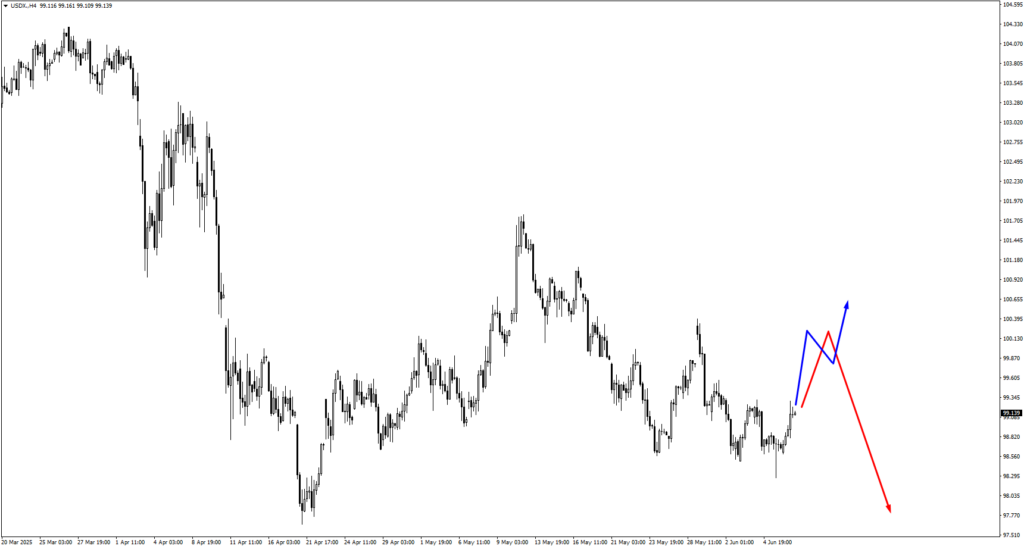
The U.S. Dollar Index (USDX) climbed just above the 98.00 zone we’ve been monitoring. At this juncture, price appears poised to either consolidate near-term before pulling back, or continue higher into the 99.80–100.50 region. That next range becomes critical. Price action there will determine whether we’re shaping a broader bullish continuation pattern or setting up for a medium-term reversal. With the Fed holding steady and inflation in check, the dollar is trading more on positioning and global demand for safety than on yield dynamics alone.
EURUSD has slipped just below the 1.1520 zone, with 1.13564 now the key support. A break below may trigger broader downside, while a bounce could signal consolidation. We’re watching closely for structure confirmation at this level, maintaining a neutral stance until direction resolves.
GBPUSD sits just below 1.3600, with attention on 1.3460 and 1.3440 as key support levels. A break lower could trigger a broader correction, while a bounce may signal consolidation. With the dollar firm and risk sentiment cautious, we remain neutral-to-bearish until a clearer structure emerges at these thresholds.
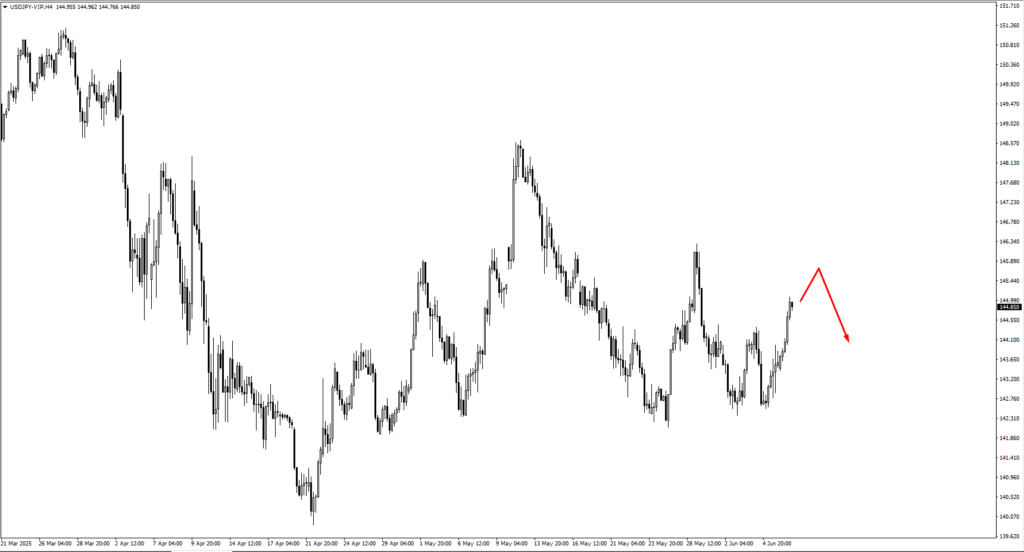
USDJPY has been grinding higher, forming what could be a larger consolidation on the weekly scale. We are eyeing the 145.75 and 146.60 levels next. A rejection at either zone, with clear bearish structure, could offer a cleaner short-side play. However, the yen remains the weakest major currency structurally, and unless yields fall sharply, further upside is not off the table.
USDCHF also continues to lean into a consolidation phase. Our eyes are on the 0.8275 zone for signs of bearish exhaustion. If momentum stalls there and structure turns, we may see short setups develop, though the Swiss franc remains fundamentally driven by safe-haven flows, especially during tariff flare-ups.
AUDUSD and NZDUSD both printed new swing highs recently but have pulled back. For AUDUSD, 0.6460 becomes the pivot for any bullish setups. For NZDUSD, we’ll look to 0.5960. Both pairs are still largely tracking broader risk appetite and commodity sentiment. Watch copper and oil as secondary indicators.
USDCAD remains in a broader up-channel structure. If price consolidates into the 1.3750–1.3780 zone and fails to break higher, we will consider bearish opportunities. Crude oil stability could also cap further CAD weakness.
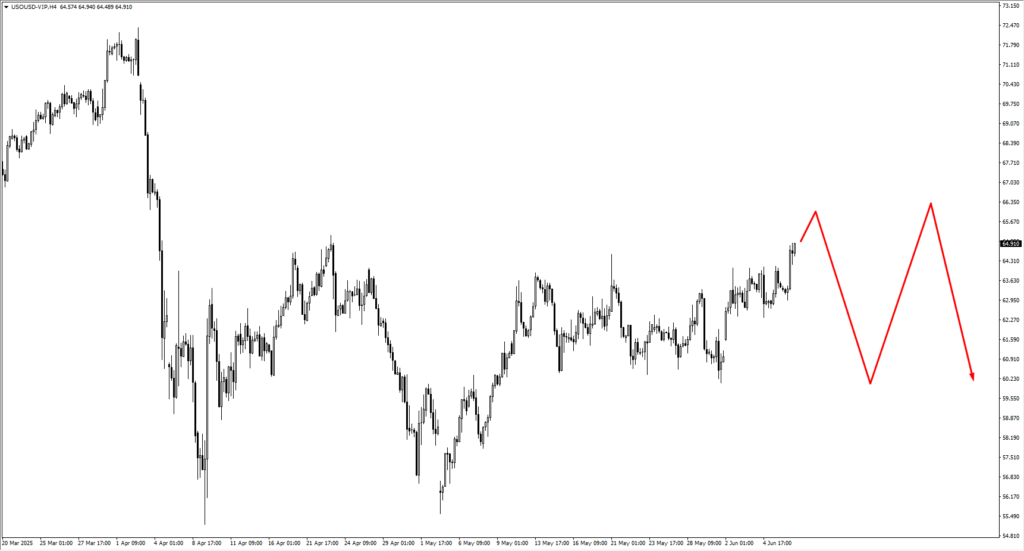
Speaking of oil, USOIL has finally begun to lift, but we remain cautious. The current move may be part of a larger consolidation. The 66.10 level is key. If price rejects there, we may see another corrective leg lower before more stable directional movement resumes. The market remains highly sensitive to geopolitical supply disruptions and trade-related demand forecasts.
Gold has been less convincing. Price failed to hold higher levels and has now revisited 3310. We anticipate a consolidation phase, with potential bearish setups at 3340. On a downward move, we are watching 3295 and 3265 for bullish price action support. Gold’s behaviour continues to reflect a lack of fear. There is no flight to safety just yet.

The S&P 500, on the other hand, continues its upward momentum. As we move higher, the 6100 level becomes the next key area. Reaction there will determine if the breakout holds or stalls. We approach this zone with caution given stretched sentiment and headline-driven volatility.
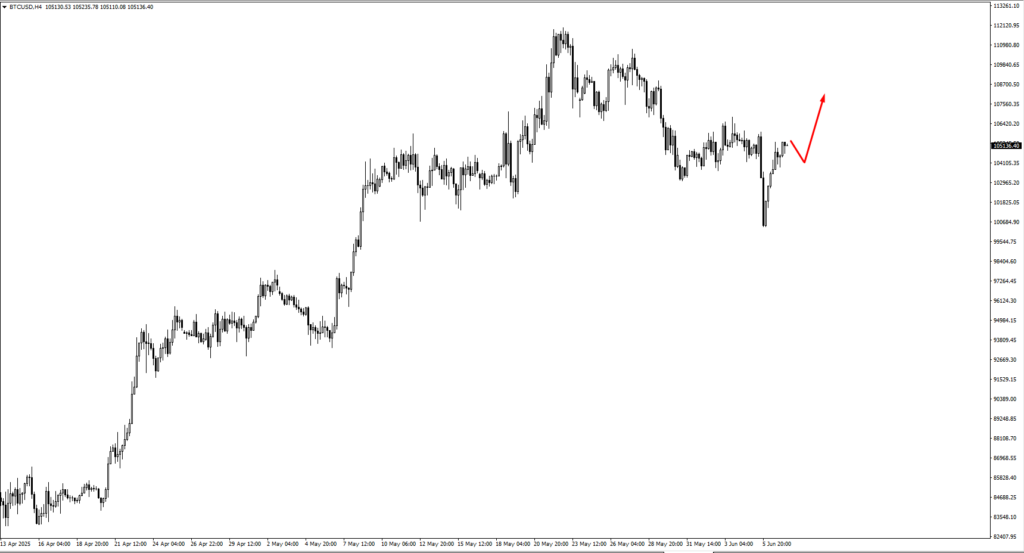
Bitcoin tested the 99,600 area and may now consolidate before attempting a move toward 107,550. Crypto markets remain highly reactive to risk appetite, regulatory headlines, and liquidity conditions. For now, structure remains bullish, but stretched.
Natural gas (Nat Gas) is showing upward momentum, but we expect resistance at 3.60. A clean bearish pattern at that level would mark a possible swing short opportunity.
As always, we monitor price zones for confirmation. Structure must align before entry. With macro sentiment holding firm but risks rising, it’s the reaction, not the forecast, that defines the trade.
Key Events This Week
Attention turns sharply to the US CPI report on Wednesday, June 11. Forecasts point to a year-on-year headline inflation rate of 2.5%, up from the prior 2.3%. A hotter-than-expected print could reignite concerns that the recent cooling in inflation may be stalling. That would likely push back expectations for a September rate cut and may firm the US dollar while weighing on risk assets. Conversely, a softer number would reinforce the recent disinflation narrative, potentially boosting equities and high-beta currencies.
On Thursday, June 12, the macro spotlight shifts to the UK and the US simultaneously. The UK GDP month-on-month figure is projected at -0.1%, down from the previous 0.2%. A downside print may weigh further on sterling, particularly if paired with risk aversion or dollar strength. Meanwhile, the US PPI is forecast at 0.2%, rebounding from last month’s -0.5%. This release will be closely watched for early signs of producer-level cost pressures feeding into consumer prices, especially in light of tariff implications.
Friday, June 13, rounds out the week with the University of Michigan Consumer Sentiment reading, forecast at 52.5 versus 52.2 previously. Though a secondary-tier release, sentiment data will offer insight into whether higher wage growth is translating into consumer confidence, or if political and trade concerns are beginning to weigh on expectations.
Create your live VT Markets account and start trading now.
In early European trading, Eurostoxx and German DAX futures fell, while UK FTSE futures gained slightly.
In May, Japan’s economy watchers index increased to 44.4, boosted by better household retail activity.
Consumer Sentiment And Business Confidence
The data indicates a slight boost in consumer mood on the high street and some growth in household spending, yet businesses, especially in manufacturing, feel uncertain. The diffusion index, which shows the percentage of respondents seeing better conditions, rose as consumers became more active, likely due to warmer weather and promotions attracting more shoppers. Nonetheless, production sectors face challenges tied to supply chain issues and shifts in global demand. Factory orders and export sentiment are weaker than expected, possibly leading to lower capital spending and hesitance in hiring in the coming months. The increase in the outlook index suggests people feel more secure in their jobs or see a slight improvement in job opportunities. This is often a lagging indicator; it doesn’t always lead to increased consumer spending, but it could indicate less hesitation in household spending if the trend continues. For traders focusing on volatility, this information could influence expectations around domestic demand and impact the yen’s value as more data becomes available.Market Dynamics And Strategic Adjustments
We see opportunities for relative value plays since short-term consumer resilience might not align with medium-term business caution. If retail data continues to strengthen without a similar rise in industrial output, the gap between consumption-focused investments and industrial ones could grow. This divergence is particularly important during the low-summer months when minor news can cause significant market movements. As market participants, we should view these indices not as definitive signals but as pieces of a broader picture that includes monetary policy, inflation trends, and local dynamics. With the Bank of Japan maintaining a unique position compared to other central banks, a sustained gap between employment expectations and manufacturing caution could open opportunities for adjusted hedging in interest-sensitive structures. Instead of making strong positions based solely on current sentiment, the data suggest better results by shifting focus to consumption-heavy sectors using short-term instruments while staying cautious on industrials until clearer signs of recovery appear. Balancing this with volatility metrics, which continue to lag behind actual moves, might allow for lower-cost entries into convexity trades within regional equity options. Throughout this period, household-led improvements are likely to fade faster than corporate recoveries solidify. We could analyze this gap by comparing small-cap performance to exporters or looking at upcoming inflation forecasts. The key lies not in the headline figures, but in how consistently consumer spending outpaces business sentiment through early summer. Create your live VT Markets account and start trading now.Dividend Adjustment Notice – Jun 09 ,2025
Dear Client,
Please note that the dividends of the following products will be adjusted accordingly. Index dividends will be executed separately through a balance statement directly to your trading account, and the comment will be in the following format “Div & Product Name & Net Volume”.
Please refer to the table below for more details:
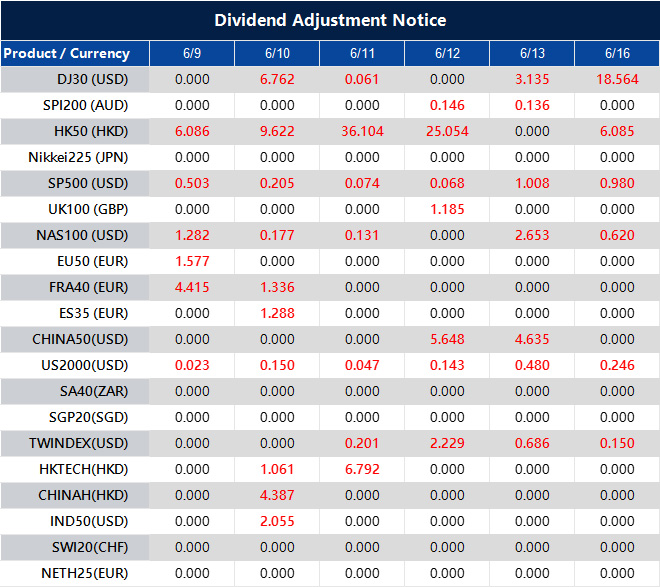
The above data is for reference only, please refer to the MT4/MT5 software for specific data.
If you’d like more information, please don’t hesitate to contact [email protected].




